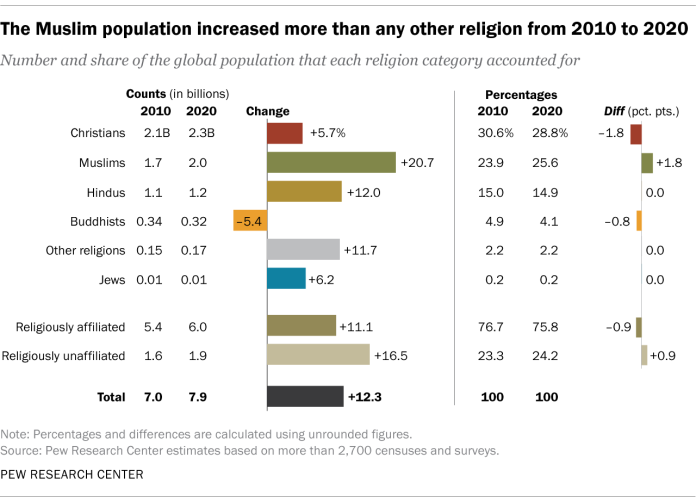In a major revelation highlighting shifting global religious demographics, a new report by the Pew Research Center confirms that Islam is currently the fastest-growing major religion in the world. While Christianity continues to have the highest number of followers worldwide, the growth rate of the Muslim population has significantly outpaced that of other faiths in recent years.
 Key Data: A Decade of Demographic Change (2010–2020)
Key Data: A Decade of Demographic Change (2010–2020)According to Pew’s comprehensive study:
The Muslim population surged by nearly 347 million, growing from 1.6 billion in 2010 to approximately 2 billion by 2020.
Consequently, the global Muslim share rose from 23.8% to 25.6% in just ten years.
In comparison, the Christian population grew more modestly — from 2.18 billion to 2.30 billion — and its global share actually declined from 30.6% to 28.8%.
Meanwhile, the religiously unaffiliated (including atheists, agnostics, and those with no religious identity) also saw an increase and now make up 24.2% of the global population.
Pew researchers attribute Islam’s rapid growth to several key factors:
Younger Median Age: Muslims have a median age of 24, which is significantly younger than the non-Muslim median age of 33. This youthful demographic naturally contributes to higher birth rates.
Higher Fertility Rates: Muslim families, on average, have more children than families of other religious backgrounds.
Lower Religious Disaffiliation: Unlike some other faith groups — particularly in the Christian world — Muslims show very low rates of disaffiliation, meaning they are more likely to remain within the faith across generations.
The Pew report forecasts that, if current trends continue:
Muslims and Christians may reach equal population levels by 2050.
By the 2070s, Islam may become the world’s largest religion.
Sub-Saharan Africa has emerged as a major Christian hub, now home to 31% of the global Christian population, largely due to high birth rates and population expansion.
In Europe and North America, the Christian share is steadily declining, while Muslim communities are expanding in size and influence.
Experts suggest that these changing demographics could influence:
Geopolitical dynamics, especially in Muslim-majority nations and regions.
Economic development, as countries with youth-heavy Muslim populations could see transformative growth and rising demand for education, jobs, and resources.
The need for greater interfaith dialogue, inclusive policies, and mutual understanding in increasingly diverse societies.
The findings from Pew underscore a powerful demographic shift, positioning Islam as a driving force in the future global religious landscape. As the world moves toward increasing pluralism and cultural diversity, the report serves as a call to embrace inclusivity, cooperation, and coexistence among different faith communities.




